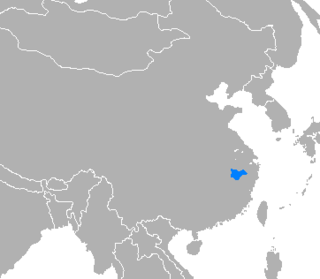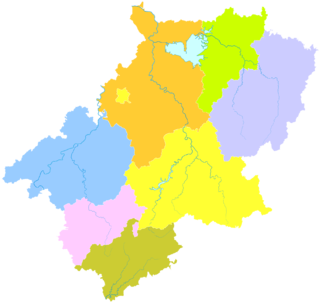Related Research Articles

Mandarin is a group of Sinitic dialects that are natively spoken across most of northern and southwestern China. The group includes the Beijing dialect, the basis of the phonology of Standard Chinese, the official language of China. Because Mandarin originated in North China and most Mandarin dialects are found in the north, the group is sometimes referred to as Northern Chinese. Many varieties of Mandarin, such as those of the Southwest and the Lower Yangtze, are not mutually intelligible with the standard language. Nevertheless, Mandarin as a group is often placed first in lists of languages by number of native speakers.

Anhui, is a landlocked province of the People's Republic of China, part of the East China region. Its provincial capital and largest city is Hefei. The province is located across the basins of the Yangtze River and the Huai River, bordering Jiangsu to the east, Zhejiang to the southeast, Jiangxi to the south, Hubei to the southwest, Henan to the northwest, and Shandong for a short section in the north.
The Shanghainese language, also known as the Shanghai dialect, or Hu language, is a variety of Wu Chinese spoken in the central districts of the City of Shanghai and its surrounding areas. It is classified as part of the Sino-Tibetan language family. Shanghainese, like the rest of the Wu language group, is mutually unintelligible with other varieties of Chinese, such as Mandarin.

Jin is a proposed group of varieties of Chinese spoken by roughly 63 million people in northern China, including most of Shanxi province, much of central Inner Mongolia, and adjoining areas in Hebei, Henan, and Shaanxi provinces. The status of Jin is disputed among linguists; some prefer to include it within Mandarin, but others set it apart as a closely related, but separate sister-group.

Huizhou Chinese, or the Hui dialect, is a group of closely related Sinitic languages spoken over a small area in and around the historical region of Huizhou, in about ten or so mountainous counties in southern Anhui, plus a few more in neighbouring Zhejiang and Jiangxi.
The Beijing dialect, also known as Pekingese and Beijingese, is the prestige dialect of Mandarin spoken in the urban area of Beijing, China. It is the phonological basis of Standard Chinese, the official language in the People's Republic of China and Republic of China (Taiwan) and one of the official languages in Singapore. Despite the similarity to Standard Chinese, it is characterized by some "iconic" differences, including the addition of a final rhotic -r / 儿 to some words. During the Ming, southern dialectal influences were also introduced into the dialect.
Teochew or Chaozhou is a dialect of Chaoshan Min, a Southern Min language, that is spoken by the Teochew people in the Chaoshan region of eastern Guangdong and by their diaspora around the world. It is sometimes referred to as Chiuchow, its Cantonese rendering, due to the English romanisation by colonial officials and explorers. It is closely related to some dialects of Hokkien, as it shares some cognates and phonology with Hokkien. The two are mutually unintelligible, but it is possible to understand some words.

Jixi County is a county under the administration of the prefecture-level city of Xuancheng, in the southeast of Anhui province, China, bordering Zhejiang province to the east. It has a population of 180,000 and an area of 1,126 km2 (435 sq mi).. Jixi County is a hilly region with many rivers and bodies of water.

Sichuanese or Szechwanese (simplified Chinese: 四川话; traditional Chinese: 四川話; Sichuanese Pinyin: Si4cuan1hua4; pinyin: Sìchuānhuà; Wade–Giles: Szŭ4-ch'uan1-hua4), also called Sichuanese/Szechwanese Mandarin (simplified Chinese: 四川官话; traditional Chinese: 四川官話; pinyin: Sìchuān Guānhuà), is a branch of Southwestern Mandarin spoken mainly in Sichuan and Chongqing, which was part of Sichuan Province until 1997, and the adjacent regions of their neighboring provinces, such as Hubei, Guizhou, Yunnan, Hunan and Shaanxi. Although "Sichuanese" is often synonymous with the Chengdu-Chongqing dialect, there is still a great amount of diversity among the Sichuanese dialects, some of which are mutually unintelligible with each other. In addition, because Sichuanese is the lingua franca in Sichuan, Chongqing and part of Tibet, it is also used by many Tibetan, Yi, Qiang and other ethnic minority groups as a second language.

Shenyang Mandarin is a dialect of Northeastern Mandarin used by people in and around Shenyang, the capital of Liaoning province and the largest city in Northeast China. It is very close to Standard Chinese but has some notably distinctive words. Some people consider it a strong accent rather than a distinct dialect. Because of its similarity to the standard language, pinyin can be used to represent its pronunciation. Its usage is dwindling as schools in Shenyang teach only the standard language.
This article summarizes the phonology of Standard Chinese.

The Longyan dialect, also known as Longyan Minnan or Liong11l11334, is a dialect of Hokkien spoken in the urban city area of Longyan in the province of Fujian, China while Hakka is spoken in rural villages of Longyan. The Longyan Min people had settled in the region from southern part of Fujian Province as early as the Tang dynasty period (618–907). Although Longyan Min has some Hakka influence to a limited extent by the peasant Hakka Chinese language due to close distance of rural village Hakka peasants of the region, Longyan Min is a close dialect of the Minnan language and has more number of tones than Hakka. The Longyan dialect has a high but limited intelligibility with Southern Min dialects such as Hokkien–Taiwanese. Today, Longyan Minnan is predominantly spoken in Longyan's urban district Xinluo District while Zhangzhou Minnan is spoken in Zhangping City excluding Chishui and Shuangyang towns where Longyan Minnan is spoken. Hakka on the other hand is spoken in the non-urban rest of the rural areas of Longyan prefecture: Changting County, Liancheng County, Shanghang County, Wuping County, and Yongding District.
The phonology of Burmese is fairly typical of a Southeast Asian language, involving phonemic tone or register, a contrast between major and minor syllables, and strict limitations on consonant clusters.

The official romanization system for Taiwanese Hokkien in Taiwan is locally referred to as Tâi-uân Lô-má-jī Phing-im Hong-àn or Taiwan Minnanyu Luomazi Pinyin Fang'an, often shortened to Tâi-lô. It is derived from Pe̍h-ōe-jī and since 2006 has been one of the phonetic notation systems officially promoted by Taiwan's Ministry of Education. The system is used in the MoE's Dictionary of Frequently-Used Taiwan Minnan. It is nearly identical to Pe̍h-ōe-jī, apart from: using ts tsh instead of ch chh, using u instead of o in vowel combinations such as oa and oe, using i instead of e in eng and ek, using oo instead of o͘, and using nn instead of ⁿ.

Lower Yangtze Mandarin is one of the most divergent and least mutually-intelligible of the Mandarin languages, as it neighbours the Wu, Hui, and Gan groups of Sinitic languages. It is also known as Jiang–Huai Mandarin, named after the Yangtze (Jiang) and Huai Rivers. Lower Yangtze is distinguished from most other Mandarin varieties by the retention of a final glottal stop in words that ended in a stop consonant in Middle Chinese.
The Nanjing dialect, also known as Nankingese, Nanjingese and Nanjing Mandarin, is the prestige dialect of Mandarin spoken in the urban area of Nanjing, China. It is part of the Jianghuai group of Chinese varieties.

Chengdu-Chongqing dialect or Cheng–Yu is the most widely used branch of Southwestern Mandarin, with about 90 million speakers. It is named after Chengdu, the capital city of Sichuan, and Chongqing, which was split from Sichuan in 1997. It is spoken mainly in northern and eastern Sichuan, the northeastern part of the Chengdu Plain, several cities or counties in southwestern Sichuan, southern Shaanxi and western Hubei.
The Ningde dialect is a dialect of Eastern Min Chinese spoken in urban areas of Ningde, China, which is a prefecture-level city in the northeastern coast of Fujian province.
The Jiangle dialect is a dialect of Shao-Jiang Min Chinese spoken in Jiangle, Sanming in northwestern Fujian province, China. It combines elements from Northern Min and Hakka Chinese.

Teochew Romanization, also known as Swatow Church Romanization, or locally as Pe̍h-ūe-jī, is an orthography similar to Pe̍h-ōe-jī used to write the Chaoshan dialect. It was introduced by John Campbell Gibson and William Duffus, two British missionaries, to Swatow in 1875.
References
- ↑ /n8697289/n8697486/n8697898/8829319.html "The Origin of Place Names in Hefei". Hefei Local Chronicles Compilation Committee Office Website. 2008-01-24. Archived from the original on 2015-08-21. Retrieved 2010-03-05.
{{cite web}}: Check|archiveurl=value (help) - ↑ "Hefei Celebrity Families Walking Out of the Slag Dam". 2010-08-25. Retrieved 2010-12-20.[ permanent dead link ]
- ↑ "Talk about Hefei". Xin'an Evening News. 2010-02-05. Retrieved 2010-03-05.[ permanent dead link ]
- ↑ "Li Hongzhang talks about abuse of fellow villagers". Sun Wu Discipline Inspection and Supervision Network. 2007-05-17. Retrieved 2010-03-05.[ permanent dead link ]
- ↑ Sun Yao (2009). "Where will Hefei dialect go". Anhui Literature (in Chinese). 2009 (4).